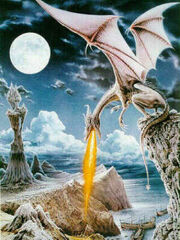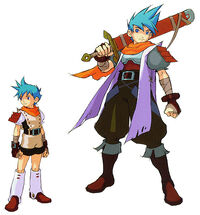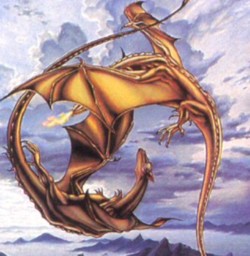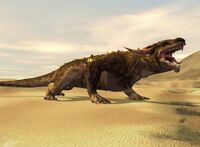A dragon is a fictional fire breathing and winged animal, often featured in Fantasy fiction. In a lot of European folklore, the dragon is depicted as evil and malicious, stealing young girls and hoarding gold. Eastern dragons, however, are viewed as wise, with festivals dedicated to them. The European dragon is large and muscular. They are usually depicted as a carnivorous dinosaur-like lizard. They stand on two or four legs in most cases, but exceptions exist. Usually, these dragons are depicted with large and powerful wings that can lift them into the sky. Meanwhile Eastern dragons more resemble a snake-like being, with no wings, and a long winding body.
more info here:
https://powerlisting.fandom.com/wiki/Dragon_Physiology
https://dragon.fandom.com/wiki/Dragon_Wikia
https://www.smartproms.com/dragones/tradicion-cultural/africa-negra/bantu/
Real history[]
Dragons are the one of the iconic fantasy creatures, and they are practically in all cultures and many religions in history, nobody knows their origin, and almost nobody can give a satisfactory explanation, but it doesn't make them less impressive. They are universal, and around the world they have different versions. Here we have some of the most commonly known types of dragons.
Celtic Europe[]
In the pre-romantic Celtic Europe we have some of the first dragons of the continent, these dragons were different than the dragons we know today. They were deities of the forest, able to communicate with sorcerers and druids with experience. They were a symbol of independence. In terms of characteristics they had bat wings instead of frontal legs (as modern dragons have), they didn't breath fire, as most dragons are known for today. They were intelligent enough to know how to talk, and they were similar to green snakes, they were kind, (excluding culebre, also called Cuélebre) so they wouldn’t be seen attacking someone.
Most of this data comes from archaeologists and roman chroniclers (some Wikipedia was used as well), because this culture didn't have a writing system (at least a standard system, as some specifics wrote using the rune system).
Norse Europe[]
Near the other side, at the north of the continent, Norse people had a completely different concept of dragons. For them (according to the references about their folklore on various websites) most dragons weren't beings of villainy or evil, they weren't deities, spirits nor animals, they were practically their own category of neutral beings. These norse dragons were usually giant, and looked like large snakes, sometimes represented with wings and other times with legs. They were magic creatures, but didn't breath fire (like the ones from Skyrim). According an interpretation of Beowulf epic poem they were able to reproduce with humans (maybe as an incubus), as of the viking writing we have no reference about gender, so they were probably hermaphrodites.
Even though most Norse dragons weren’t evil, tales of villainous dragons were still told. These dragons were against the gods, like Nidhug, others had great treasures (these were the inspiration of medieval classic tales featuring/of dragons). The kind dragons were able to protect people from evil spirits, and protect coasts.
Greek mythology[]
In Greece and the mediterranean coasts, we have the first notion of modern west dragons. Dragon (and its equivalents in some other languages) comes from the latin word DRACO, that comes from greek δράκων, that means sneak, used to refer to snake-like monsters and vipers. In greek mythology, dragons cannot fly, they were usually represented as giant snake with different abilities and two frontal legs, the most popular of these snake-dragons are the hydra, the python, Colchis' dragon, and Ladon.
Roman Mythology[]
The roman dragons were a reinterpretation of greek dragons, with elements of other cultures, adding the four legs and the occasional wings. They were a symbol of power, but weren't used frequently, as eagles represented a similar thing. Some common Roman “dragons” were the Chimera (a hybrid), the Cetus, and the Arimanius.
Christian Europe (in middle age)[]
When christianity started its expansion around Europe with the help of the roman empire, it became official in many ancient territories on the domain of other cultures. The christian religion already had dragons of jew origin, like the leviathan and the beast of the apocalypse, but their presence was ignored until the expansion of the religion. When it expanded, it merged with roman dragons. Later the catholic church noticed that the cults of Europe gave tribute to dragons instead of Jehovah (a christian God). Then the authorities of the organization decided to make them real, but with some differences, these dragons became red, breathed fire, looked more reptilian than snake-like, and had horns. They still had the characteristics of most of the ancient dragons, but these dragons were known as evil. They were no longer ancient mystic beings. They had become dark creatures of evil, that had to be hunted.
Fun fact: Some merchants used to take dead iguanas and stitch the wings of bats to their backs, and falsely sell them as baby dragons.
Sea Serpents[]
In some maps and bestiaries it's possible to find some giant aquatic snakes and/or dinosaur-like lake creatures, like Nessie, for example. Those are considered as dragons of water (or sea serpents), they cannot breath fire, an are enormous, and can quite possibly be aggressive.
Dragons in Persia[]
In Persia, dragons were known as evil spirits that could set courses in the lands near their nests. They looked quite like Griffons.
Arabic dragons[]
In the Arabic empire (and Andalucía) the idea of the dragons had less impact than in Europe, but they had dragons, these dragons were morphologically similar to the Persian dragons. As in christianity, they were creatures of evil, they were poisonous, they either had breath of fire, but used their poison abilities more frequently, and they used to use their tail and wings as weapons to use their poison. There aren’t a lot of tales about them, therefore it’s difficult to find information in them
Far Eastern Dragons[]
In East Asia dragons were spirits of water and air, they had the hability to talk with gods, so they deserved (and deserve) respect, these magical creatures were wise and strong, a symbol of China's unity, anatomically they have many variations, but tipically they have horns, representing their link with nature, the head of a horse or a sneak with feathers, ears of bull, a moustache, a blue (or green), a long body of fish and a tail full of feathers, sometimes legs and hands with claws.
Based on an interpretation of the legend of Sun Wukong (the king Monkey) these dragons were enough intelligent to make a underwater society, to battle against other dragons they didn't use their strenght, istead they used weapons and their knowledge of magic. If you find a dragon, you are considered a lucky person, or a person that is gonna be lucky.
Between Bantu people[]
In Bantu beliefs there are to types of dragons, as in vikings' mythology they can (probably) reproduce with humans.
The high deities[]
in the tribe Baga, the Chokwe folklore, the Kongo cosmogony and zimbabwean tales dragons are deities (the gods have form of dragons), these dragons are similar to giant snakes, they created whole comunities, the sea and in some versions life in general the main group of dragons are from Kongo cults, they are Mboze and kuitkuiti's descendants, gods of water and life, creators of the universe, these cultures reffers to this dragons as gods or godesses, so they have gender differentiation.
The evil monsters[]
Mainly according Miyoni people and legends from Angola there are other kind of dragon, they are less powerful than the other dragons (in most of the cases), they usually live in lakes, like sea dragons, they descend from gods, are the cause of all the pain in the world.
According native Americans[]
North[]
In Northamerica there is nearly no information about dragons in the stories of the indigenous, the only one I could find was Piasa, it's not enough information about it.
Mesoamerica (centroamérica)[]
Mayans and Mexicas (Aztecs) have the story of Quetzalcoatl, a great flying snake with feathers, god of the rain, the Earth creation and the peace, main responsible of the cration of the Sun, the Moon and Venus, he asked his followers to feed him (as the sun) with human sacrifice and gave them visions when they eat mushrooms. The snake is the symbol of the earth and the bird of the spirit, so the meaning of the symbol of quetzalcoatl is the travel of the sprit to the heaven, some cults in mexico say that quetzalcoatl is a representation of Christ.
Southamerica[]
The yngas (inkans) thought that the lightning was a creature, but not any creature; the Amaru, a beast (or spirit depending the version) able to travel through the heaven, the hell and the Earth at the speed of light, representation of the sea and the storms, with a head of a llama (beast of Earth), the wings of a condor (beast of the heaven) and the tail of a sneak(beast of the hell), sometimes it's represented with the body of a boa, other times with the body of a jaguar and/or wings of a bat instead of a condor, it has the job of messenger.
The Wayuu people tell that in their mythology the rain is the god Juya, a snake (dragon) hunter, he is enemy of Kasipoluin, the snake of the rainbow, it is giant and able to speak, some people say that Kasipoluin isn't the rainbow, instead it is the great boa Sarulu, in other myths it is a creature called Maliwa, it is not defined what is Maliwa, some people describe it as a sneak, some others as an iguana, a another part as an alligator, maybe it is a mixture (a quimera).
Ethiopia[]
Ethiopia a long time ago, before the colonization, became to christianity, this make their vision of dragons similar to the european dragons, we have info of a mention of dragons in the story of Saint Efigenia, so we can be sure about their existence in the canon of their main religion.
Before christianity many greek stories about dragons are in Ethiopia, these dragons are catergorized as Drakones aithiopikoi (the dragons of Africa). At the north of the country, in the ancient region of Nubia people didn't believe in dragons.
Polynesian[]
Some people think that Polynesians had dragons inspired in continental America, because there are proofs that polynesians had contact and comercial relationships with Mayans and Yngas, but if these Austronesian dragons existed they probably desapeared with some of their myths.
Yoruba[]
In santería, the yoruba religion are adapted to christian religion and some concept from christianity get mixed with the beliefs of this group, there is not many info to confirm the idea of dragons in Yoruba cults, but it's possible, considering that Yorubas have a word for dragons; Dragoni.
Nilota[]
Not eough info.
Buhmen and Tswana[]
Not enough info.
Modern times[]
Nowadays dragons are a current resource in modern fantasy, inspired in medieval tales, many people say that dragons doesn't exist, but many creatures are called with that name and most of the religions, cults and cultures with dragons still exist, some of those dragons in concept and historically are dragons but are no longer considered dragons, like Loch Ness monster, the christian dragons, etc. So saying that dragons doesn't exist depends in your concept of dragon and in some cases can be considered unrespectful because their existance in many cults, like chinese classic cults, african animism, indigenous cosmogony, neopaganism, conspiracy theories, cryptozoology, etc.
[NEED MORE INFO, PLEASE ADD A CONCLUSION].
Dragonlance[]

A typical dragon from Dragonlance
The dragonlance series of books and games is owned and run by Wizards of the Coast. As the name implies, it makes heavy usage of dragons in the books.
The dragons in the Dragonlance series by Weis and Hickman are differentiated by the 'type' of dragon. For example, a red dragon can breathe fire, a blue dragon can breathe lightning, and a white dragon can breathe ice. These types of dragons tend to spend their time with their kin. They are often portrayed as demigods, and almost infinitely wise.
Breath of Fire series[]

Ryu from Breath of Fire III
In the Breath of Fire series, dragons are not something in and of themselves. Instead, dragons are humans that turn into dragons. In fact, there is only one dragon in each Breath of Fire game. His name is always Ryu and he is the descendant of the Ryu from the previous game. He is always depicted with blue hair, and always uses a sword as his weapon of choice.
J.R.R Tolkien's The Hobbit[]
In The Hobbit, there is only a single dragon, and its name was Smaug. Smaug was a greedy and evil creature which acquired a large horde of treasure by capturing the Lonely Mountain. Smaug was very intimately familiar with each piece of treasure in his inventory. He had reddish-gold scales and resembled a large dinosaur, a typical portrayal of the European dragon. There is also a dragon named Glaurung the Deceiver in Tolkien's The Silmarillion, who seems to have been similar in appearance and personality to (but much more powerful than) Smaug.
Anne McCaffrey's Pern[]

Queen dragon mating flight.
Anne McCaffrey's classic novels create a world called Pern in which dragons are beautiful, sentient beings incapable of life without a human partner, with whom the individual dragon can communicate telepathically. The death of the human partner results in the immediate suicide of the dragon; the human partner may commit suicide or choose to live a half-life traumatized by the termination of the bond.
Although later books more fully explain the creation of the dragons and the origin of human life on Pern, McCaffrey's original books tell of a vivid world plagued by an organic life-consuming menace called Thread. Thread will eat through any organic matieral until killed by drowning in water, frozen by ice or charred by fire. It comes in cycles of fifty year "Passes" in which Thread "falls" and 200 year times without Threadfall. Twice in Pern history, the 200 year breaks are doubled so that 400 years pass without Threadfall. The Pernese have developed a system to fight the Thread menace, namely the creation of enclaves, called Weyrs, of "dragonriders" and their dragon-partners.
There are six main Weyrs throughout most of Pernese history: Fort Weyr (the first and most prestigious); Benden Weyr (the second Weyr); Telgar Weyr (created at the same time as Benden); High Reaches Weyr (within the High Reaches Mountains); Ista Weyr (on an island); and Igen Weyr (in the desert). Most of McCaffrey's novels focus on Benden, Fort, and High Reaches Weyrs, though Dragon's Eye is set at Telgar. The six Weyrs are far enough apart that they can adequately protect Pern.
The dragons of Pern are very special and complex characters. Not all Pernese can become dragonriders so it is a matter of pride and privilege to have a dragonrider in the family. The dragons choose their human partner at birth, through a ceremony called Impression. The dragon bursts from his or her shell and stumbles his/her way towards the ring of candidates for Impression until he/she finds his/her rider. Once a dragon has chosen his or her rider, the bond cannot be broken outside of death. The bond is so strong that it is extremely unusual for a dragon to permit another rider to ride him/her into Threadfall, should his/her rider be unable to do so, as happens when Naton, a non-rider, rides Canth into Threadfall in Dragonquest.
The dragons are divided into an inherent social stratification based seemingly only on the color of the individual dragon. There are five natural dragon colors (in order of rank): queen or gold (female); bronze (male); brown (male); blue (male); and green (female). The queen is the rarest of the dragons with each Weyr averaging, at most, three or four queens. The eldest queen dragon is the Queen of the Weyr: her rider is the Weyrwoman and indisputable female leader of the Weyr, responsible also for the Records, basic unity, and major transactions and agreements between her Weyr and the others. The younger queen dragons and their riders often change Weyrs through inter-Weyr agreements. The rider of the bronze dragon who mates with (or rather, "catches")the queen dragon when she is in heat (called a mating flight) becomes the Weyrleader, the male leader of the Weyr.
Only a bronze dragon may mate with the queen due to physiological differences between the bronze, brown and blue dragons. A brown dragon will never become larger than the average size of a bronze,with one exception being Canth. It states often that Canth is the size of most of the bronzes on Pern. likewise, a blue will never become larger than an average brown. Also, a blue would never be interested in mating with a queen dragon, only with a green.
A queen dragon mates every three years and so leadership of the Weyr can change dramatically in one day. Although queen mating flights inherently result in sexual intercourse between the riders during a queen mating flight, the Weyrleader does not necessarily become the Weyrwoman's lover. Queen dragons never learn to flame however, because chewing firestone makes a dragon infertile. This is useful because greens mate quite frequently, and if they could lay eggs the weyrs would become overrun very quickly.
Beneath the bronzes and golds are the browns. Each dragon knows at birth into which classification he or she falls, so there is no confusion between the bronzes and the browns. Bronzes may become Wingleaders, leaders of the 33 member fighting formations formed during Threadfall. Browns may become Wingseconds or Weyrlingmasters, those who help with newly Impressed dragons and their partners. There is some mention of resentment between the browns and bronzes in regards to mating rights.
Below the browns are the two most specific, populous and useful dragons: the blues and the greens. These dragons are the fastest and most manueverable dragons, though they tire faster than the larger dragons. Blue dragons may become Weyrlingmasters but rarely achieve higher rank (though in the psychology of McCaffrey, the blue riders have no desire for anything more; that is why blue dragons are attracted to them). Green dragons are the most volatile of the dragons because they are also female and have mating flights. However, over Pernese history, a lack of adequate female candidates resulted in a belief that greens could only Impress male candidates. Thus, McCaffrey provides a logical place in Pernese society for male homosexuality: green dragons Impress effeminate gay men and blue dragons Impress more masculine gay men. This does leave questions about the knowledge of homosexuality outside of the dragonriders (would a family understand that Impression of a green or blue dragon was an almost certain indication of homosexual tendencies?) and the extent of it within and without of the Weyr (How often do greens mate? answer: quite often. How would sexual partners arrange mating rights? Is there sexual interaction between green and brown riders?- remember, the dragons have individual personalities and sexual preferences; answer: sometimes, but it's not mentioned often. but they do mate with greens since they cant with queens. Would sexual frustration of a brown dragon lead to unwanted homosexual activity? answer: no. the weyr is very open to the rituals of mating, and riders have ways of venting frustrations. Must all blue riders be inherently gay? answer: not necessarily. some may riders may arrange for a female to be present during the mating flight, and the other men with the same option. What dragonrider would be forced to couple with an unpopular greenrider? What would sexual parters do if their dragons disliked each other or if the green should prefer another dragon? answer: preferences can play a good deal into which dragon catches the female, but during the flight things like this dont matter. even if the riders hated each other, during that moment they would be so caught up in their dragons passion they wouldnt notice at all).
The Sword of Truth[]
In Terry Goodkind's Sword of Truth novels, dragons are depicted as quite intelligent, and are a bit more benevolent than traditional European dragons (but still carnivorous, and viciously protective of their young). If Scarlet is any indication, Goodkind's dragons have an excellent sense of humor as well. In the Sword of Truth novels, dragon teeth have powerful magic, including the ability to summon the dragon from which the tooth was taken. They breathe fire, but don't seem to use this ability much.
Dragoncharm[]
The Dragoncharm series by Graham Edwards is unusual in that it is written entirely from the dragons' point of view. In this respect it has been likened to Richard Adams's Watership Down. Edwards has created a mythical prehistory in which two species of dragons - "charmed" and "natural" - initially battle, then later unite. The four-legged, winged charmed dragons use magic - or "charm" - to breathe fire and manipulate the world around them. The natural dragons are also winged, but have only two legs. Unlike their charmed cousins, they cannot use magic at all.
Star Wars[]
In Star Wars, a universe originally only pictured in movies by George Lucas but not also including things like novels, comics, video games and more, several reptilian species are referred to as dragons. None of them, however, are capable of breathing fire, though some can fly.

A canyon krayt dragon on Tatooine.
The most famous of them are propably the krayt dragons. There is two subspecies of the krayt dragon, the smaller but more common one being the canyon krayt dragon. There is also the bigger, ten-legged greated krayt. The krayt dragon is a huge lizard with venomous teeth and, in the case of the canyon krayt, spines. They were fierce hunters, but had difficulties in discerning two-dimensional pictures. During their grinding of food, they created the rare and valuable dragon pearls which could be used to enhance the effect of a lightsaber.
A possibly ancestor of the krayt dragons was the sentient species Duinuogwuin, or Star Dragons. They were highly intelligent, and had an ability rare among sentient species; they could survive in the vacuum of space. They could also grow just as large as the greater krayt dragons, thus sometimes reaching a length of 100 meters. They had the ability to fly using some internal organs.
A smaller relative of the krayt was the kell dragon. Though they could not by any chance match the power of the krayts, they were still dangerous creatures.
Other dragon species in the Star Wars universe includes the Arkanian dragon, the Billinus dragon and the Ubese Thorn-Back War Dragon. While the krayt, the kell and possibly the Star Dragons are relative, it is unknown if the rest are. Thus, it is unknown if the term "dragon" in Star Wars refers to a certain line of lizards, or if it is just a term for dangerous and big reptiles.
Christopher Paolini's Inheritance Series[]
In Christopher Paolini's Inheritance Series, dragons have a close relationship with Elves. They can also form bonds between a group of humans called the Dragon Riders, which are warriors that battle with dragons as their pets. The dragons in this novel mature from a newborn baby to a dragon that is capable of feeding itself and flying within months. At the time of this story, dragons have almost become extinct, with the majority of the eggs being possessed by an evil king called Galbatorix.